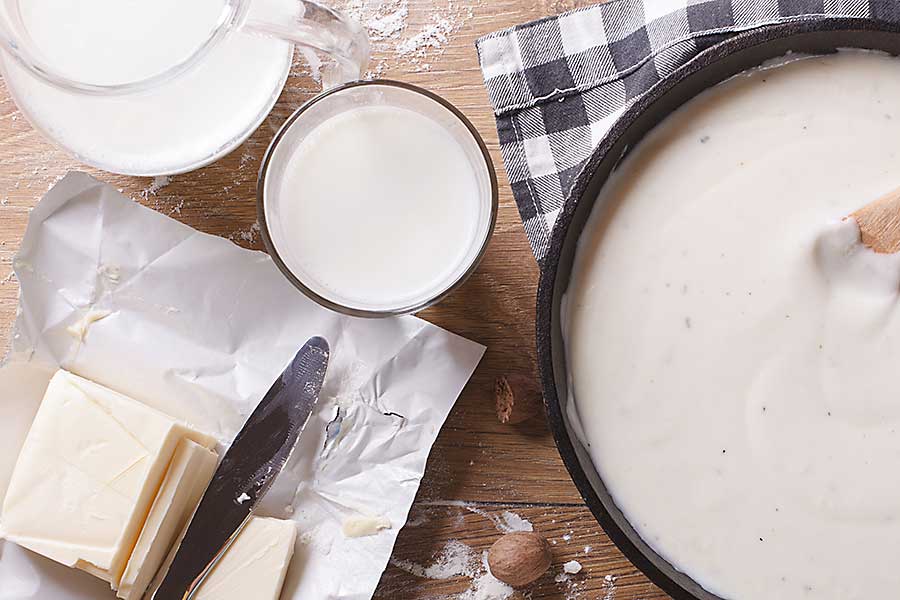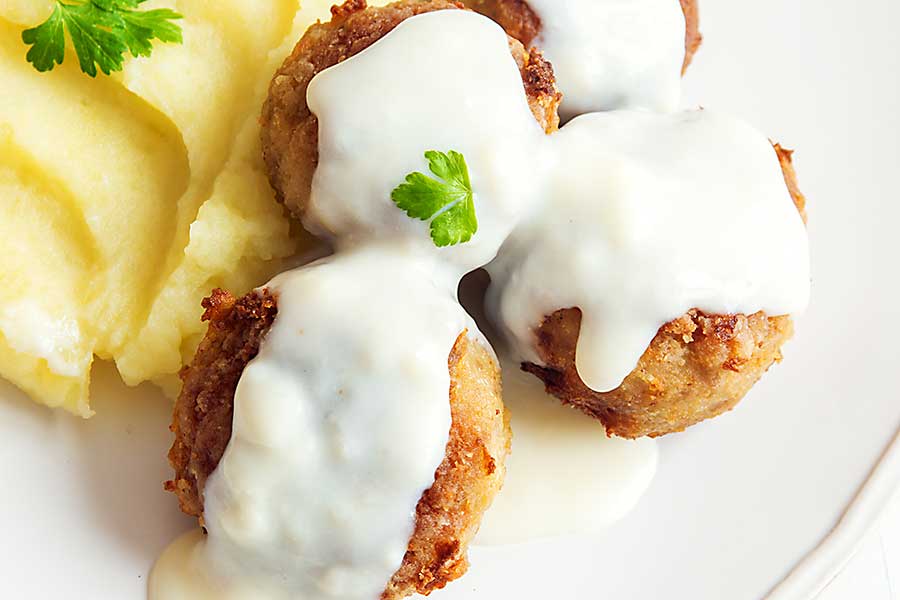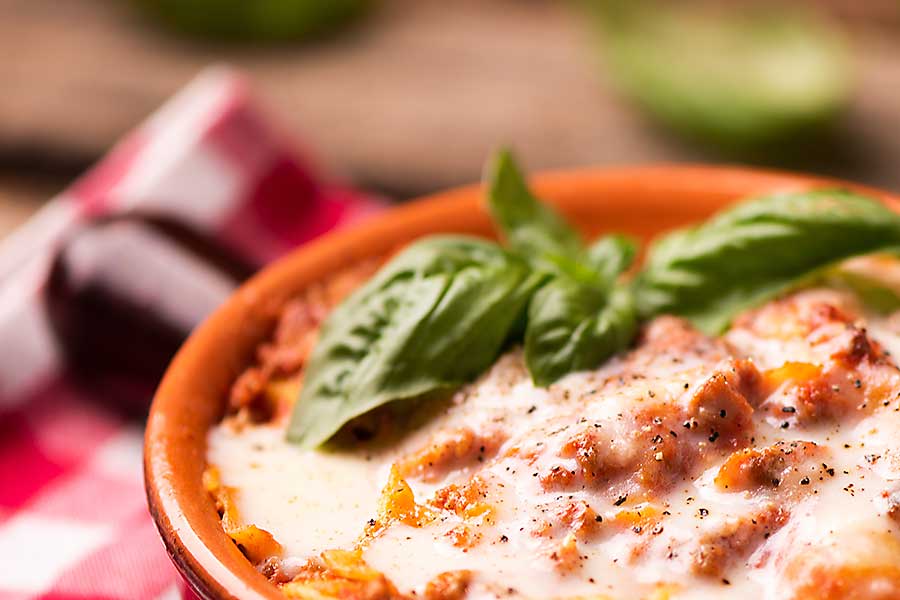Béchamel Sauce
Béchamel sauce is a silky white sauce made from milk and thickened with butter and flour. It is one of the five mother sauces used in French cuisine, meaning it is a base used for other, more complex sauces such as Mornay or Alfredo. Béchamel sauce is a staple in many Italian and French dishes, including lasagne, gratin, and croque monsieur. While it has been popularised in French cuisine, béchamel sauce is attributed to an Italian origin, from the regions of Tuscany and Emilia-Romagna. In Italian, the sauce is referred to as balsamel or beschiamella.
History of béchamel sauce
Béchamel sauce has its beginnings in Tuscany during the renaissance era, when it was referred to as the ‘glue sauce’ thanks to its sticky, thick consistency. The creamy white sauce was introduced to France in 1533 by the chefs of Catherina de Medici (wife of Henry II). It is so named after Louis de Béchamel, chief steward to King Louis XIV in France. While often featured in Italian cookbooks of the renaissance period (as the glue sauce – salsa colla), it was renamed in 1651 when published in the cookbook Le Cuisinier Francois, considered to be a foundation of French cuisine.
How do you make béchamel sauce?
Béchamel sauce today is simply made by cooking a roux of butter and flour, which is used to thicken the sauce. Warm, full-cream milk is then added to this mixture and whisked into the sauce. While béchamel sauce is creamy and rich, cream is rarely used in the recipes. The traditional recipes from early cookbooks are much more complex, however.
In a 1700s traditional recipe, béchamel sauce was made by cooking onion skins and root vegetable peels in butter, later adding spring onion and parsley to the mixture. Once cooked, cream is then added to the vegetables and seasoned with black pepper, salt, and nutmeg. This was then boiled and strained, with more butter added to the final sauce.
A more modern recipe – also described in a 1700s cookbook – outlines first melting butter and then frying shallots with parsley and spring onion. Later, cream is added along with the seasonings as well as extra parsley, and the sauce is served as is without straining. In Provence, béchamel sauce is made using olive oil instead of butter.
What sauces can you make from béchamel?
With béchamel sauce as a base, you can make a number of other derivatives, including:
- Mornay – A rich sauce with added grated cheese, such as gruyère and parmesan, and egg yolk. Add stock to make a variation of velouté.
- Aurora – A creamy sauce made by mixing béchamel with tomato sauce.
- Soubisse – A French sauce made by mixing sautéed and puréed onions with béchamel.
- Parsley sauce – A classic English sauce made by mixing béchamel with parsley and lemon juice.
- Nantua – A seafood sauce made by mixing béchamel with cream and crayfish or shrimp butter & meat.
- Cream sauce – Also known as sauce crème, this classic sauce is made by whisking heavy cream into béchamel and adding salt and pepper.
What dishes use béchamel sauce?
When you know how to make béchamel sauce, you open yourself up to a whole new world of cooking. Béchamel sauce is the secret ingredient to a number of popular dishes, adding thick and creamy goodness to anything! Here are some popular dishes that use béchamel sauce:
- Lasagne – Béchamel sauce is used between the layers of pasta sheets and bolognese,
- Chile con queso – Use béchamel sauce to give more life to this cheesy Tex-Mex dip,
- Croquettes – Make croquettes even tastier by filling them with creamy béchamel sauce as well as your choice of filling,
- Moussaka – A traditional moussaka uses a thick and creamy béchamel sauce to lighten its heartiness,
- Chowder – The secret to a creamy chowder is thick, delicious béchamel sauce,
- Tuna mornay – A mornay sauce is basically béchamel sauce with cheese,
- Pasta bake – Or, really, any bake is made better with the rich creaminess of béchamel,
- Chicken pie – Add béchamel to your pie filling for an extra special flavour,
- Mac n cheese – Just drown your pasta in delicious béchamel sauce and you’ve got an easy homemade mac and cheese,
- Bouchée à la Reine – This classic French starter is made even more delectable when it’s drowning in béchamel.
How to make dairy free béchamel sauce?
Classic béchamel sauce isn’t vegan-friendly, since it relies on dairy products as its major ingredients. That said, you can easily replace these dairy products with plant-based ingredients to make a vegan béchamel sauce. Just follow the same recipe as above for classic béchamel sauce, and substitute a few ingredients:
- Use your choice of plant-based milk instead of the dairy milk. We like using soy milk. Make sure it is unsweetened, and go for a product that includes a thickening agent to keep that creamy béchamel consistency.
- You can easily substitute the butter with any vegan butter or even olive oil.
Private Chefs, Art of Dining
CHEFIN is a private chef platform that’s reimagining social dining.
You can easily connect with 1 of our 250 private chefs and treat your guests to restaurant-quality dining experiences in the comfort of your own home, office or chosen venue. From high-end dining to quirky social food experiences, the CHEFIN platform makes it effortless for you to access gourmet food that’s worthy of a Michelin-starred establishment.
What you get:
-
- Your very own private chef who is vetted and insured,
- A customised menu for your needs,
- 24/7 concierge support,
- Complete post-dinner cleanup,
- A fun, stress-free, and unforgettably dining experience!


